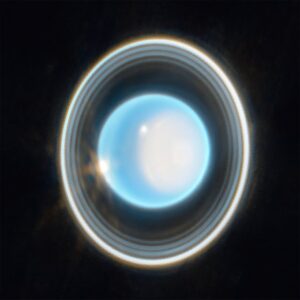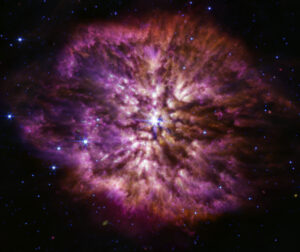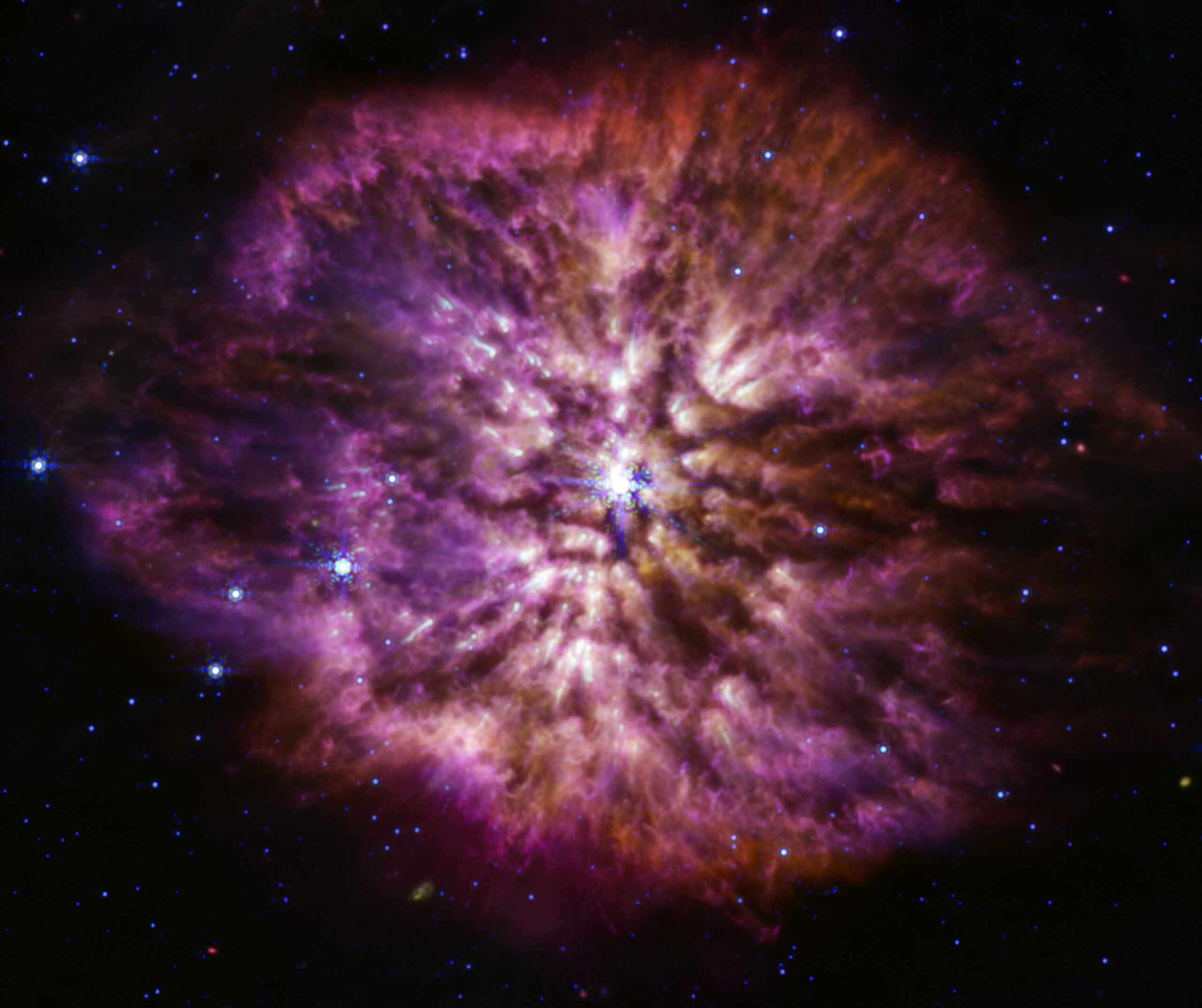Two panel discussions were devoted to the Webb Space Telescope at SXSW in Austin last month: one on engineering, the other on science.
“What we’re seeing in this beautiful new image is the very centre of a star, 15,000 light years away,” explained Dr. Amber Straughn, astrophysicist at Goddard Space Flight Centre in Maryland. “The material you are seeing around the central star is dust. At the end of a star’s life they shed their outer layers. I think this is one of the most beautiful concepts in all of astronomy. The fact the iron in your blood and calcium in your bones was literally forged inside of a star that exploded billions of years ago. That’s what we’re seeing in this new image: the dust is spreading out into the cosmos and will eventually create planets. That is how we got here!”
Visiting from the European Space Agency was Dr. Macarena Marin. She is Deputy Project Scientist in the Webb Mission Office. Marin talked further about this image of a type of star known as Wolf-Rayet. .” She explained the amount of material it has shed is 10 times the mass of our Sun. “These Wolf-Rayet stars are really big and bright and incredibly hot. This particular one is 30 times the mass of our Sun. When stars are this big they live fast. It’s really unique that we can see inside this star with this detail for the first time in the infrared.”
The Webb, unlike the Hubble Space Telescope, observes in the infrared. “Infrared in the fraction of light that is really sensitive to temperature; everything that has a temperature from our bodies to a piece of ice. This lets us see through the gas and dust to see the central star nurseries and we can look back in time to see the very first objects in the universe, more than 13 billion years ago,” said Marin. “These first few months of data,” said Straughn, “are surprising us. In the very early universe, the galaxies are much bigger and brighter than we expected. We don’t really understand why.”
Stephanie Milam, Deputy Project Scientist for Planetary Science for the Webb, said we will also be looking much closer to home. The incredible image of the planet Uranus, shown here, was released this month. “We’re going to be observing everything in our solar system from Near-Earth asteroids, comets, interstellar objects, all of the planets and their satellites, to the farthest reaches of our solar system including our favourite minor planet, Pluto.”

Knicole Colon, Webb Exoplanet scientist, explained that the space telescope will also be studying planets that orbit other stars using spectroscopy. So far more than 500 exoplanets have been discovered. “We have to be creative in the techniques we use to study exoplanets. Webb is really great at doing spectroscopy: we’re taking a rainbow of light and breaking it down so we can measure the chemical fingerprints of objects in the universe. One way we can look at the atmospheres of exoplanets is when they pass in front of stars. We can see starlight blocked by the planet plus its atmosphere, so we can study what gets filtered by the atmosphere to reveal what the atmosphere is made of.”
“We’ve already some great discoveries,” Colon said. One she highlighted was the presence of carbon dioxide in the atmosphere of a planet 700 light years away. It is called WASP-39b. “The reason is so groundbreaking is because it’s the first definitive detection of carbon dioxide outside the solar system.”
Before all this could happen, the telescope had to be built, and that took 20 years! “People want to know why it took 20 years to build on the ground,” said Scott Willoughby, Vice President and Program Manager for the Webb. “We didn’t get the chance to make it seven times heavier.”
The Webb had to be placed at the so-called Lagrange point, a million miles away from Earth. “The weight limit to get there was 6,530 kg. The year after I took over the program I learned we were 6,700 kg. It turns out we weren’t getting off the ground: we had to put Webb on a diet. We literally had to fit every composite, smaller gauge wires, etc. We started light but we still weren’t going to get off the ground.” In pounds, the Hubble weighs 25,000 pounds, but Webb is only 12,000.
The mirrors of the telescope had to be folded together to fit in the rocket that launched it. Unfurling those panels in space, with no gravity, had to be simulated on Earth before launch to ensure it would happen. This proved to be immensely difficult.
“On Earth gravity pulled it down, but then you go into orbit and all of a sudden there’s no gravity, so you’re in trouble. We couldn’t put it water to simulate zero gravity. We had hundreds of engineers designing how to zero-G this, literally by using cables. We had lots of intricate designs where we were cable off-loading through the ceiling with a counterbalance set of weights so that as we’re deploying we’re simulating how the opposite vector of gravity, and trying to make sure everything worked in its free form. One of the other tricks was really cool. The shape of the sunshield was very important: how the layers would interact with each other. One of the smart aleck ideas was: well, it’s sagging in gravity so we tested it and turned it over and tested it sagging in the other direction. We created a computer model and subtracted them and said in zero-G it’s going to be in the middle. It’s things like that we had to invent.”
Webb launched on Dec. 25, 2021 and should work for 10 years or more. Its lifetime is limited by the fuel required to keep it in a parking orbit at the same distance from Earth. With a development cost of $10 billion, NASA will be funding it at a rate of $187 million a year. To put that in some perspective, the U.S. along has directed more than $75 billion in assistance to Ukraine, to defend itself against the Russian evil. Both expenses, in space and on the ground, are the price we must pay for knowledge and security.
Lead photo: Official image description
Wolf-Rayet stars are known to be efficient dust producers, and the Mid-Infrared Instrument (MIRI) on the NASA/ESA/CSA James Webb Space Telescope shows this to great effect. Cooler cosmic dust glows at the longer mid-infrared wavelengths, displaying the structure of WR 124’s nebula. The nebula is made of material cast off from the ageing star in random ejections, and from dust produced in the ensuing turbulence. This brilliant stage of mass loss precedes the star’s eventual supernova, when nuclear fusion in its core stops and the pressure of gravity causes it to collapse in on itself, and then explode. As MIRI demonstrates here, Webb will help astronomers to explore questions that were previously only available to theory, questions like how much dust stars like this create before exploding in a supernova, and how much of that dust is large enough to survive the blast and go on to serve as a building block of future stars and planets.
Credit: NASA, ESA, CSA, STScI, Webb ERO Production Team
Photo of Uranus, caption by NASA:
Check out the polar cap (bright white area) on the right side! Webb reveals, for the first time, a subtle enhanced brightening at its center. This polar cap appears in the direct sunlight of summer and vanishes in the fall. Webb’s data will help us to understand this mystery. Eleven of the planet’s 13 rings are visible, though some are so bright they appear to blend into one ring. Credit: NASA, ESA, CSA, STScI, Webb ERO Production Team

